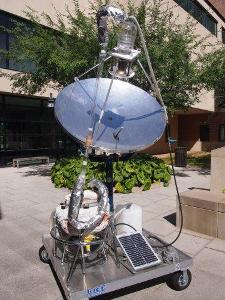Sep 10 2013
A revolutionary new solar energy technology that turns water into steam without boiling the entire container of water has become the basis for new devices to sanitize medical and dental instruments and human waste in developing countries, scientists said here today.
 A “solar autoclave” can sterilize medical instruments and wastes without using electricity Credit: Oara Neumann, Rice University
A “solar autoclave” can sterilize medical instruments and wastes without using electricity Credit: Oara Neumann, Rice University
Prototypes of the devices, which need no electricity or fuel, were the topic of one of the keynote addresses at the opening of the 246th National Meeting & Exposition of the American Chemical Society (ACS), the world’s largest scientific society. The meeting, which features almost 7,000 reports on new advances in science and other topics, continues through Thursday in the Indiana Convention Center and downtown hotels.
Naomi Halas, D.Sc., pointed out that almost 2 billion people live in areas of the world without a regular supply of electricity. That electricity is key to using machines called autoclaves, which produce scorching-hot steam to sterilize medical and dental instruments. Without that basic machine, doctors must rely on chemicals, which can be costly and difficult to transport, to prevent the spread of germs and disease from medical and dental instruments.
“We have developed a solution, our solar steam technology,” Halas said. She is with Rice University. “It is completely off-grid, uses sunlight as the energy source, is not that large, kills disease-causing microbes effectively and relatively quickly and is easy to operate. This is an incredibly promising technology.”
Halas and colleagues have prototypes of two solar steam machines. One is the autoclave for sterilizing medical and dental instruments. The second is an autoclave for disinfecting human and animal wastes, which are another major source of disease transmission in developing countries and other resource-limited areas. The technology could be expanded to provide steam for direct use in purifying dirty or salty water for drinking and cooking — with the solar-generated steam simply allowed to condense into pure distilled water. Possibilities also exist for adapting the technology to produce steam to spin small electric turbines to generate electricity.
Their tests showed that the prototype autoclaves produced steam at temperatures ranging from 239 to 270 degrees Fahrenheit. Steam production adequate for sterilization began within about 5 minutes. It continued for periods of time long enough to sterilize liquid and solid materials placed inside the device, consistent with U.S. Food and Drug Administration sterilization guidelines. The heat and pressure produced by the steam was great enough to kill the most heat-resistant living microbes, and also viruses and the tough spores that microbes form to survive hostile environmental conditions.
The autoclaves are the first practical applications of a new solar energy technology described earlier in 2012 in ACS Nano, one of the ACS’ more than 40 peer-reviewed scientific journals. Metallic nanoparticles — bits of material so small that hundreds would fit inside the period at the end of this sentence — go into a container of water. Sunlight focused into the water quickly heats the nanoparticles, which scientists are terming “nanoheaters.” A layer of steam forms on the nanoheaters and buoys them up to the water’s surface. They release the steam and sink back down into the water to repeat the process.
“Nanoheaters generate steam at a remarkably high efficiency,” Halas said. “More than 80 percent of the energy they absorb from sunlight goes into production of steam. In the conventional production of steam, you would have to heat the entire container of water until it boils, with the bubbles rising to the top to release steam. With nanoheaters, less than 20 percent of the energy heats the neighboring liquid.”
The prototype autoclaves consist of a dish-like mirror that focuses sunlight into a container of water with the nanoheaters.
A video on the solar heater technology is available here.
Halas recently formed a company that is working on moving the devices from the prototype stage to commercial products. She and her collaborators are seeking ways to make them more rugged and at a more reasonable cost. They are also exploring even more applications for the technology.
Halas acknowledged funding from the Bill and Melinda Gates Foundation.
To automatically receive news releases from the American Chemical Society, contact [email protected].